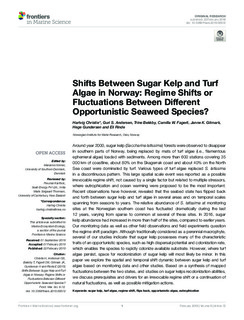| dc.contributor.author | Christie, Hartvig C | |
| dc.contributor.author | Andersen, Guri Sogn | |
| dc.contributor.author | Bekkby, Trine | |
| dc.contributor.author | Fagerli, Camilla With | |
| dc.contributor.author | Gitmark, Janne Kim | |
| dc.contributor.author | Gundersen, Hege | |
| dc.contributor.author | Rinde, Eli | |
| dc.date.accessioned | 2019-06-26T13:34:04Z | |
| dc.date.available | 2019-06-26T13:34:04Z | |
| dc.date.created | 2019-02-13T14:50:44Z | |
| dc.date.issued | 2019 | |
| dc.identifier.citation | Frontiers in Marine Science. 2019, 6, 72. | nb_NO |
| dc.identifier.issn | 2296-7745 | |
| dc.identifier.uri | http://hdl.handle.net/11250/2602389 | |
| dc.description.abstract | Around year 2000, sugar kelp (Saccharina latissima) forests were observed to disappear in southern parts of Norway, being replaced by mats of turf algae (i.e. filamentous ephemeral algae) loaded with sediments. About 80% of the observed stations on the Skagerrak coast and about 40% on the North Sea coast were affected. Various types of turf algae replaced S. latissima in a discontinuous pattern. This large spatial scale event was reported as a possible irrevocable regime shift, not caused by a single factor but related to multiple stressors where eutrophication and ocean warming were proposed to be the most important. Recent observations have however revealed that the seabed state has flipped back and forth between sugar kelp and turf algae in several areas and on temporal scales spanning from seasons to years. The relative abundance of S. latissima at monitoring sites at the Norwegian southern coast has fluctuated dramatically during the last 12 years. The abundance of S. latissima has varied from sparse to common at several of these sites. In 2016, sugar kelp abundance had increased in more than half of the sites, compared to earlier years. Shifts from kelp forests to turf have not earlier been documented to recover, and such events are described as irrevocable regime shifts. The monitoring data as well as other field observations and field experiments question this regime shift paradigm. Although traditionally considered as a perennial macrophyte, several of our studies indicate that sugar kelp possess many of the characteristic traits of opportunistic species, such as high dispersal potential, high colonization rate, which enables the species to rapidly colonize available substrate. However, where turf algae persist, space for recolonization of sugar kelp will most likely be minor. In this paper we explore the spatial and temporal shift dynamic between sugar kelp and turf algae based on monitoring data and other studies. Based on a synthesis of mapped fluctuations between the two states, and studies on sugar kelps recolonization abilities, we discuss prerequisites and drivers for both irrevocable regime shifts and natural fluctuations, as well as possible mitigation actions. | nb_NO |
| dc.language.iso | eng | nb_NO |
| dc.publisher | Frontiers Media | nb_NO |
| dc.rights | Navngivelse 4.0 Internasjonal | * |
| dc.rights.uri | http://creativecommons.org/licenses/by/4.0/deed.no | * |
| dc.title | Shifts between sugar kelp and turf algae in Norway: regime shifts or flips between different opportunistic seaweed species? | nb_NO |
| dc.type | Journal article | nb_NO |
| dc.type | Peer reviewed | nb_NO |
| dc.description.version | publishedVersion | nb_NO |
| dc.rights.holder | Copyright © 2019 Christie, Andersen, Bekkby, Fagerli, Gitmark, Gundersen and Rinde. | nb_NO |
| dc.source.pagenumber | 10 | nb_NO |
| dc.source.volume | 6 | nb_NO |
| dc.source.journal | Frontiers in Marine Science | nb_NO |
| dc.identifier.doi | 10.3389/fmars.2019.00072 | |
| dc.identifier.cristin | 1677055 | |
| dc.relation.project | Norges forskningsråd: 160016 | nb_NO |
| cristin.unitcode | 7464,20,11,0 | |
| cristin.unitname | Marin biologi | |
| cristin.ispublished | true | |
| cristin.fulltext | original | |
| cristin.qualitycode | 1 | |

